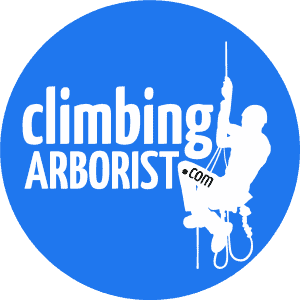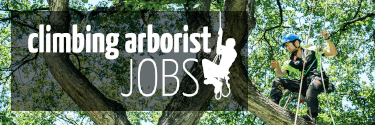There are a couple of variations of the Acronym SRT the first was ‘Single rope technique’ because the climber is climbing on a single leg of rope. Through discussions this term was highlighted as maybe not being the most clear, because when you climb on the traditional method you are still on a single rope, it is just doubled over (DdRT). So an alternative (which I really like) is ‘Stationary rope technique’ , this term explains that the rope is fixed, and still uses the acronym SRT.
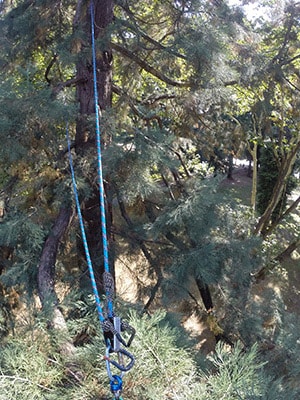 Forms of SRT have been around for many years, for tree climbing this was only in the form of accessing the tree using cammed ascenders or some form of prusik setup incorporating foot loops.
Forms of SRT have been around for many years, for tree climbing this was only in the form of accessing the tree using cammed ascenders or some form of prusik setup incorporating foot loops.
A rope tool called the Unicender then hit the market and solved the problem of being able to switch between ascent and descent without changing over any equipment. For tree climbers this is imperative due to the nature of our work we are always moving up, down and sideways.
The real game changer for SRT in the tree world came with the design and the release of the rope wrench. This device provides that seamless transition from ascent to descend while allowing the climber to still keep the familiarity of their friction hitch. The rope wrench works by adding additional friction above the hitch to prevent the hitch from over heating and possibly melting on descent, and from locking up solid under to weight of the climber.
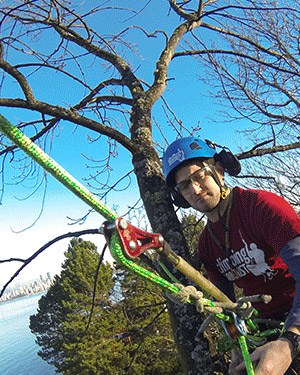 So why would you choose to climb SRT over the traditional DdRT?
So why would you choose to climb SRT over the traditional DdRT?
The reason SRT has made such an impact in the tree climbing world is due to the advantages you can have over climbing DdRT. Before you even get off the ground you have the advantage with installing your line, the benefit you get is not having to isolate your line around a single branch, the climbing line can run over multiple branches and be anchor at the base.
You then have the access/ascent part of the climb, this is made significantly easier with SRT due to the fact you can utilize both of your legs to walk your way into the canopy rather than muscling your way up using your arms. For me personally one of the biggest realizations was how much abuse my shoulder was taking when hauling my way up a tree on a doubled system, once I had a nice SRT ascent setup I felt like I was cheating because I had removed so much effort from the climb.
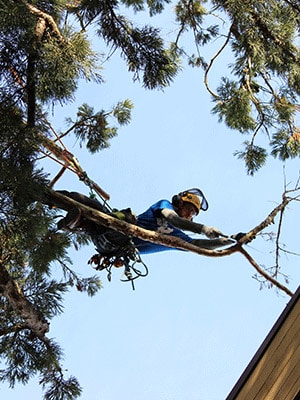 Once in the canopy and your SRT friction device (whether it be mechanical or hitch) feels natural, movement through the canopy is not really any different, the basic fundamentals of work positioning, keeping your weight in the harness, using the rope angles and pendulums to swing through the canopy are all the same. The fundamentals might be the same but the fact that the rope is stationary now becomes a huge advantage, 2 or 3 long limb walks on the same side of the canopy can in many cases be made much easier by redirecting through a fork from a limb above. Now this is possible with DdRT but the added friction of the rope passing through the fork as well as the rope on rope friction can make this a frustrating experience, not to mention the climb back to your redirect. Now do this on an SRT system and there is no change to the way your friction device reacts, so the limb walks become a ‘walk in the park’ and your ascent back up to your redirect through open space is all to easy on your SRT system.
Once in the canopy and your SRT friction device (whether it be mechanical or hitch) feels natural, movement through the canopy is not really any different, the basic fundamentals of work positioning, keeping your weight in the harness, using the rope angles and pendulums to swing through the canopy are all the same. The fundamentals might be the same but the fact that the rope is stationary now becomes a huge advantage, 2 or 3 long limb walks on the same side of the canopy can in many cases be made much easier by redirecting through a fork from a limb above. Now this is possible with DdRT but the added friction of the rope passing through the fork as well as the rope on rope friction can make this a frustrating experience, not to mention the climb back to your redirect. Now do this on an SRT system and there is no change to the way your friction device reacts, so the limb walks become a ‘walk in the park’ and your ascent back up to your redirect through open space is all to easy on your SRT system.
When planning your climb you can set the length of the working part of your rope so that you only have an additional 10-15ft touching the ground, this can save lots of pulling excess rope through the canopy if you have a long rope or the tree isn’t overly tall, as long as redirects are planned for that may require a little extra rope.
Every tree climber at some point has had their rope trapped, caught or hooked somewhere in the canopy while climbing on a DdRT system, when you attempt to descend to sort out the issue you inevitably get to that point where you can go no further because the tail of your line isn’t free to feed through and you are stuck. This can be somewhat frustrating or plain embarrassing as the groundsman can do nothing but heckle. If this scenario was to happen on an SRT system the climber can descend down to the point and clear or untangle the mess without any heckling or red faces.
The more you climb the more you realize other minor benefits of SRT.
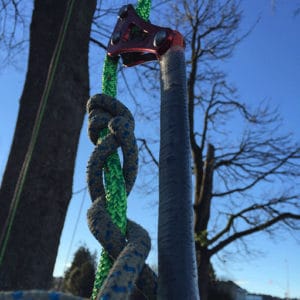 With all this being said, I personally still climb certain trees using a DdRT climbing system. There are a number of reasons that I base my decision on when choosing the climbing system and every tree presents a different challenge. Having been trained climbing with a traditional doubled rope system and climbing like this for the first 8 years of my career it will always be an important part of my toolbox. It certainly has its advantages when ascending a tree if a line can not be set from the ground (rope over rope climbing), or if it makes sense because it is an easy climb (lots of branches like a ladder). DdRT can also be easier when returning in from a long limb walk especially if the limb is slightly dropping downwards.
With all this being said, I personally still climb certain trees using a DdRT climbing system. There are a number of reasons that I base my decision on when choosing the climbing system and every tree presents a different challenge. Having been trained climbing with a traditional doubled rope system and climbing like this for the first 8 years of my career it will always be an important part of my toolbox. It certainly has its advantages when ascending a tree if a line can not be set from the ground (rope over rope climbing), or if it makes sense because it is an easy climb (lots of branches like a ladder). DdRT can also be easier when returning in from a long limb walk especially if the limb is slightly dropping downwards.
It is my belief that if you were being taught to climb, you should always be taught the DdRT system first and become proficient at it before progressing on to Single rope work positioning. The reason being, I think you need the understanding of the way the two systems work and when they can be utilized, but i’m sure my opinion is biassed due to the way I was trained.
It would be interesting to see a new breed of climber that climbs purely on an SRT system, and the techniques they use where many others my switch to DdRT.
Others may disagree but it is my opinion that SRT is definitely worthy of all the hype and the fuss. I am a firm believer in training and that individuals and tree care companies shouldn’t be scared of trying new techniques and evolving, and should embrace SRT and invest in SRT training courses which will pay dividends in future years for both production and wear and tear on the individual.
Videos on various parts of SRT climbing can be viewed on our SRT series page
